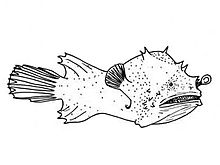| Photocorynus | |
|---|---|

| |
| Female P. spiniceps | |
| Scientific classification | |
| Domain: | Eukaryota |
| Kingdom: | Animalia |
| Phylum: | Chordata |
| Class: | Actinopterygii |
| Order: | Lophiiformes |
| Family: | Linophrynidae |
| Genus: | Photocorynus Regan, 1925 |
| Species: | P. spiniceps
|
| Binomial name | |
| Photocorynus spiniceps Regan, 1925
| |
Photocorynus is a monospecific genus of marine ray-finned fish belonging to the family Linophrynidae, the leftvents.[2][3] The only species in the genus is Photocorynus spiniceps.
Photocorynus was first proposed as a genus in 1925 by the English ichthyologist Charles Tate Regan when he described its only species, P. spiniceps.[4] The holotype of P. spiniceps was collected by the Danish research vessel Dana[2] from the Gulf of Panama at 7°15'N, 78°54'W, froma depth of around 1,250 m (4,100 ft).[5] The 5th edition of Fishes of the World classifies this taxon in the family Linophrynidae, within the suborder Ceratioidei, the deep sea anglerfishes, of the anglerfish order Lophiiformes.[6]
Photocorynus means "light club", an allusion to the bioluminescent sac at end of the short, club-like illicium. The specific name, spiniceps, means "spiny head", a reference to the robust spines on the sphenotic bone.[7]
The known mature male individuals are 6.2–7.3 millimeters (0.25-0.3 inches), smaller than any other mature fish and vertebrate; the females, however, reach a significantly larger size of up to 50.5 millimeters (2 inches).[8][9] Numerous fish species have both sexes reaching maturity below 20 millimeters (0.8 inches).[10]
Photocorynus spiniceps has a circumglobal distribution in the Atlantic and Pacific Oceans. In the Atlantic Ocean it has been recorded from both sides between 32°N and 13°S. In the Pacific it has been recorded from Japan, Hawaii and the Gulf of Panama. specimens have been taken from depths betweem 990 and 1,420 m (3,250 and 4,660 ft).[1]
Like most other deepsea anglerfishes, Photocorynus spiniceps lures its prey into striking range using a bioluminescent sac at the end of an illicium, the highly modified first ray of the dorsal fin, and swallows the prey whole with the help of a distending jaw and a similarly distending stomach. Its prey can sometimes be as big as their own bodies. The male spends its life fused to its much larger female counterpart, therefore effectively turning her into a hermaphrodite. It is important to note that the male has to bite the female in order to spend the rest of its life fused together.[11]
While the female takes care of swimming and eating, the male, with a large proportion of its body consisting of testes, is charged with the task of aiding reproduction.
- ^ a b Arnold, R. (2015). "Photocorynus spiniceps". IUCN Red List of Threatened Species. 2015: e.T42830286A42837307. doi:10.2305/IUCN.UK.2015-4.RLTS.T42830286A42837307.en. Retrieved 21 August 2024.
- ^ a b Charles Tate Regan (1925). "Dwarfed Males Parasitic on the Females in Oceanic Angler-Fishes (Pediculati Ceratioidea)". Proceedings of the Royal Society B. 97 (684): 386–400. Bibcode:1925RSPSB..97..386T. doi:10.1098/rspb.1925.0006.
- ^ Froese, Rainer; Pauly, Daniel (eds.). "Photocorynus spiniceps". FishBase. February 2006 version.
- ^ Eschmeyer, William N.; Fricke, Ron & van der Laan, Richard (eds.). "Genera in the family Linophrynidae". Catalog of Fishes. California Academy of Sciences. Retrieved 21 August 2024.
- ^ Eschmeyer, William N.; Fricke, Ron & van der Laan, Richard (eds.). "Species in the genus Photocorynus". Catalog of Fishes. California Academy of Sciences. Retrieved 21 August 2024.
- ^ Nelson, J.S.; Grande, T.C.; Wilson, M.V.H. (2016). Fishes of the World (5th ed.). Hoboken, NJ: John Wiley & Sons. pp. 508–518. doi:10.1002/9781119174844. ISBN 978-1-118-34233-6. LCCN 2015037522. OCLC 951899884. OL 25909650M.
- ^ Christopher Scharpf (21 August 2024). "Order LOPHIIFORMES (part 2): Families CAULOPHRYNIDAE, NEOCERATIIDAE, MELANOCETIDAE, HIMANTOLOPHIDAE, DICERATIIDAE, ONEIRODIDAE, THAUMATICHTHYIDAE, CENTROPHRYNIDAE, CERATIIDAE, GIGANTACTINIDAE and LINOPHRYNIDAE". The ETYFish Project Fish Name Etymology Database. Christopher Scharpf. Retrieved 21 June 2024.
- ^ Theodore W. Pietsch (2005). "Dimorphism, parasitism, and sex revisited: modes of reproduction among deep-sea ceratioid anglerfishes (Teleostei: Lophiiformes)". Ichthyological Research. 52 (3): 207–236. Bibcode:2005IchtR..52..207P. doi:10.1007/s10228-005-0286-2. S2CID 24768783.
- ^ Doughton, Sandi (January 31, 2001). "Catch of the day: Researcher stakes claim to tiny-fish title". The Seattle Times. Archived from the original on 18 May 2008. Retrieved 2 February 2006.
- ^ S. H. Weitzman & R. P. Vari (1988). "Miniaturization in South American freshwater fishes; an overview and discussion". Proceedings of the Biological Society of Washington. 101: 444–465.
- ^ Kessler, R. (2006). Fish Story in Reverse. Natural History, 115(3), 32.
